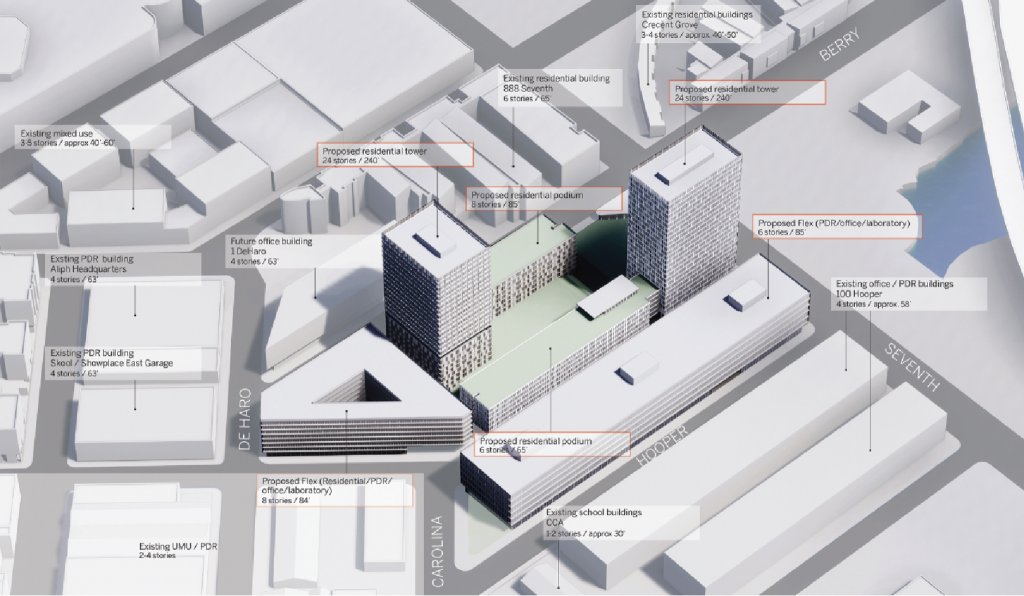
Recology, the firm that collects San Francisco’s garbage, has ambitious plans to recycle a truck parking lot located at 900 Seventh Street into 1,048 housing units, mixed with commercial and industrial space.
The project has several hurdles to pass, the largest of which may be that Recology will need to convince the City to rezone the land. Under the Eastern Neighborhoods Plan, adopted in 2009, the block was designated for Production, Distribution and Repair (PDR) as a means to preserve space for industry, which usually can’t compete with rents paid by commercial or residential users. PDR heights are also limited to 58 feet; Recology is proposing building two towers that climb to 240 feet.
A preliminary plan filed with the San Francisco Planning Department indicates that the company wants to subdivide the six-acre land into four separate parcels. Two would be entirely residential, featuring the twin 24-story towers connecting to six- and eight-story structures. Another would consist of a six-story commercial building for PDR, office or laboratory usage. A fourth, ranging eight stories,would be equally flexible, including potentially adding residential units.
“The proposed project contemplates a similar mix of uses, maintaining the historic character of PDR/office uses, as well as meeting the ever-growing need for both market and below-market housing units in the City,” the plan states. Twenty-five percent of units would be set aside as affordable; 20 percent very affordable.
Eric Potashner, Recology’s director of strategic affairs, noted that the eight-story flex building would be parallel to and the same rectangular shape as 100 Hooper, a six-story edifice recently constructed for office and PDR use. The residential towers would be at opposing corners of the site to preserve views from within the project and adjacent properties. Public open space is proposed on the corner of Seventh and Berry streets.
The property rests in an awkward spot between two street grids, one that dominates South of Market and the north-south network that permeates most of Dogpatch and Potrero Hill. The parcel is a five-minute walk from the six neighborhoods that surround it – SoMa, China Basin, Mission Bay, Potrero Hill, Dogpatch and the Mission – but doesn’t offer access between them. The Caltrain railyard obstructs traffic across Seventh Street to the north. Three streets – Mission Bay Drive to the east, Alameda to the west and Carolina to the south – end at the block.
“The streets all stop at our property. They don’t go through,” said Potashner. To solve some of the grid issues, Recology proposes to extend Alameda Street to Seventh Street.
Under the moniker “Recology Golden Gate,” the company has been using the site to primarily park 120 trucks in conjunction with dispatch and maintenance services. Those lorries serve Chinatown, North Beach, Downtown and the Marina. According to Potashner, those uses can be merged into its Tunnel Avenue site at the Brisbane/San Francisco border.
“They drive down to Tunnel Avenue and that’s where they dump. They are going down there every day anyway. And then they drive all the way back,” he said. “The main thing is that we wouldn’t be sending 120 trucks in and out of the neighborhood.”
While Potashner noted PDR use would expand compared to what Recology does at the site now, he admitted he’s gotten a sense that City planners want to take a breath before looking at the merits of moving PDR zoning to mixed use. The Planning Department declined comment to the View other than to say it considered protecting PDR a high priority. The department is due to release an assessment letter on the preliminary plan this month.
It’s likely that in their assessment of Recology’s concept, planners will be mindful of the future of the 19-acre railyard, which could be moved south of the City should the Fourth and King Streets station be closed when tracks are linked to the new Salesforce Transit Center. All current proposals call for those tracks to be undergrounded, which could open three million additional square feet for development adjacent to Recology’s parcel. However, the railyard’s fate is several years from being decided.
J.R. Eppler, Potrero Boosters president, questioned whether the Recology site lends itself to residential use. In addition to the train tracks, he noted that Interstate-280 passes by, there’s no open space and the parcel is several blocks from transit in any direction.
“That site is remote from a residential standpoint, and thus building a dense residential facility there doesn’t make sense from a planning standpoint,” he said.
While Eppler acknowledged the need for more residential development in the City, he said PDR should be a necessary component at the location.
“The development of the parcel should respect the zoning that was established as part of the Eastern Neighborhood Plan. When that area was rezoned as PDR it was done to ensure PDR jobs did not get removed by the City. Whatever gets developed at the Recology site needs to acknowledge the zoning and work well with PDR neighbors.”
Among those neighbors are PlaceMade, one of 100 Hooper’s tenants. PlaceMade is a sister nonprofit of SFMade, which is dedicated to helping manufacturers stay and grow in San Francisco. Another PDR neighbor is slated across the street at 1 De Haro, where a building, which’ll also include office space, is expected to be constructed and open by 2020. However, there’s a residential building at 888 Seventh Street, and the California College of the Arts is developing student housing two blocks down Seventh Street.
Recology has commissioned the architectural firm, Skidmore, Owings and Merrill (SOM), to develop its design. SOM, a global company with a San Francisco office, includes among its recent credits One World Trade Center in New York City and Burj Khalifa, the world’s tallest building, in the United Arab Emirates.
In addition to approximately 1.4 million square feet of building space, the proposal calls for 1,061 parking spaces at a rate of 0.7 spaces per residential unit and one space per 1,200 square feet of nonresidential floor area.

